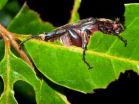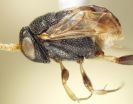Study shows lower verbal test score for toddlers who play non-educational games on touch screens
2014-05-03
(Press-News.org) VANCOUVER, BC --A recent study by pediatricians from the Cohen Children's Medical Center of New York examined infants 0-3 years old that used touch-screen devices to determine if their use was of any educational benefit to infants and toddlers. The study showed that children who played non-educational games using touch-screen devices had lower verbal scores upon testing.
The results also showed that although the majority of parents cited in the study believed their children received educational benefits by using smart phones, readers and tablets, there was no statistical difference in developmental scores in children who played educational games versus non-educational games.
"We have observed in our neonatal clinic that the number one "toy" parents are giving their toddlers are smart phones," said Ruth Milanaik, DO, chief investigator of the study and an attending developmental and behavioral physician at the Cohen Children's Medical Center of New York in New Hyde Park. "It was striking to see that parents were substituting books and general baby toys for smart phones. Many parents did not seem to bring any other distraction for their children except the touch screen devices."
Dr. Milanaik noted that the 2011 American Academy of Pediatrics' (AAP) policy predated recent technological advances such as smart phones and tablets and discouraged the use of electronic media in children younger than age 2, citing potential adverse development risks and lack of evidence supporting educational benefits. The new 2013 AAP guideline cites positive and prosocial effects of media use but does not address children 0-3. The relationship between using touch-screen devices and cognitive development of this population had yet to be studied, according to Dr. Milanaik.
Of the 65 families surveyed, 63 (97 percent) owned a touch screen device. The average age of the child when starting to use a touch-screen device was about 11 months and average use was about 36 minutes daily. The most common forms of touch screen device usage was watching children's "educational shows" (30 percent), using educational applications (26 percent), pressing buttons on the screen aimlessly (28 percent), and playing non-educational games (14 percent). Sixty percent of parents reported "educational benefits" of their child using a touch screen device. The study showed there was no significant difference in testing scores between children who used touch-screen devices and children without the same exposure to touch-screen devices. However, results indicated that children who play non-educational games (ie. Angry Birds, Fruit Ninja, etc.) have a lower verbal score on developmental tests.
"Technology can never replace a parent's interaction with his or her child. Just talking to your child is the best way to encourage learning" Dr. Milanaik said.
INFORMATION:
To schedule an interview with Dr. Milanaik, call 516-633-7416 or email RMilanai@nshs.
To view the abstract, "Relationship between Cognitive Development and Touchscreen Device Usage in Infants and Toddlers" go to: http://www.abstracts2view.com/pas/view.php?nu=PAS14L1_1531.472&terms=
The study is being presented at the Pediatric Academic Societies in Vancouver, BC on Saturday May 3, 2014 at 1:00 p.m., Exhibit Hall C, Vancouver Convention Center.
No outside funding was received for this research.
The Pediatric Academic Societies (PAS) are four individual pediatric organizations that co-sponsor the PAS Annual Meeting – the American Pediatric Society, the Society for Pediatric Research, the Academic Pediatric Association, and the American Academy of Pediatrics. Members of these organizations are pediatricians and other health care providers who are practicing in the research, academic and clinical arenas. The four sponsoring organizations are leaders in the advancement of pediatric research and child advocacy within pediatrics, and all share a common mission of fostering the health and well-being of children worldwide. For more information, visit http://www.pas-meeting.org. Follow news of the PAS meeting on Twitter at http://twitter.com/PedAcadSoc.
ELSE PRESS RELEASES FROM THIS DATE:
Nearly 50 percent of M.D.s believe diversion of ADHD stimulant medications among teens is a problem
2014-05-03
VANCOUVER, BC – Two recent studies by investigators at the Cohen Children's Medical Center of New York examined physicians' perceptions and knowledge of diversion of stimulant medications for Attention Deficit Hyperactivity Disorder (ADHD) as well as practices physicians use to prevent diversion among their patients prescribed these medications.
The results showed that while almost half of all physicians surveyed believe diversion is common among teens with ADHD, the majority never received training on the topic. Furthermore, about one-third of physicians rarely counsel ...
UN targets on health risk factors can prevent 37 million deaths by 2025
2014-05-03
Reaching globally-agreed targets for health risks such as smoking and alcohol can prevent more than 37 million deaths by 2025.
A new international study led by Imperial College London has estimated how achieving globally-agreed targets for six important health risks between 2010 and 2025 will reduce deaths caused by the big-four chronic diseases: cancers, diabetes, lung disease and cardiovascular disease (mainly heart disease and stroke).
Published in The Lancet the study finds that achieving the targets can prevent over 37 million deaths from these diseases by 2025. ...
The Lancet: Reducing just 6 risk factors could prevent 37 million deaths from chronic diseases over 15 years
2014-05-03
Reducing or curbing just six modifiable risk factors—tobacco use, harmful alcohol use, salt intake, high blood pressure and blood sugar, and obesity—to globally-agreed target levels could prevent more than 37 million premature deaths over 15 years, from the four main non-communicable diseases (NCDs; cardiovascular diseases, chronic respiratory disease, cancers, and diabetes) according to new research published in The Lancet.
Worryingly, the findings indicate that not reaching these targets would result in 38.8 million deaths in 2025 from the four main NCDs, 10.5 million ...
Leaf chewing links insect diversity in modern and ancient forests
2014-05-03
Observations of insects and their feeding marks on leaves in modern forests confirm indications from fossil leaf deposits that the diversity of chewing damage relates directly to diversity of the insect population that created it, according to an international team of researchers.
"The direct link between richness of leaf-chewing insects and their feeding damage across host plants in two tropical forests validates the underlying assumptions of many paleobiological studies that rely on damage-type richness as a means to infer changes in relative herbivore richness through ...
Salk scientists reveal circuitry of fundamental motor circuit
2014-05-02
LA JOLLA—Scientists at the Salk Institute have discovered the developmental source for a key type of neuron that allows animals to walk, a finding that could help pave the way for new therapies for spinal cord injuries or other motor impairments related to disease.
The spinal cord contains a network of neurons that are able to operate largely in an autonomous manner, thus allowing animals to carry out simple rhythmic walking movements with minimal attention—giving us the ability, for example, to walk while talking on the phone. These circuits control properties such as ...
Which came first, bi- or tricellular pollen? New research updates a classic debate
2014-05-02
With the bursting of spring, pollen is in the air. Most of the pollen that is likely tickling your nose and making your eyes water is being dispersed in a sexually immature state consisting of only two cells (a body cell and a reproductive cell) and is not yet fertile. While the majority of angiosperm species disperse their pollen in this early, bicellular, stage of sexual maturity, about 30% of flowering plants disperse their pollen in a more mature fertile stage, consisting of three cells (a body and two sperm cells). And then there are plants that do both.
So which ...
Researchers find unique fore wing folding among Sub-Saharan African Ensign wasps
2014-05-02
Researchers discovered several possibly threatened new species of ensign wasps from Sub-Saharan Africa -- the first known insects to exhibit transverse folding of the fore wing. The scientists made this discovery, in part, using a technique they developed that provides broadly accessible anatomy descriptions.
"Ensign wasps are predators of cockroach eggs, and the transverse folding exhibited by these species may enable them to protect their wings while developing inside the cramped environment of cockroach egg cases," said Andy Deans, associate professor of entomology, ...
Probing dopant distribution
2014-05-02
The icing on the cake for semiconductor nanocrystals that provide a non-damped optoelectronic effect may exist as a layer of tin that segregates near the surface.
One method of altering the electrical properties of a semiconductor is by introducing impurities called dopants. A team led by Delia Milliron, a chemist at Berkeley Lab's Molecular Foundry, a U.S Department of Energy (DOE) national nanoscience center, has demonstrated that equally important as the amount of dopant is how the dopant is distributed on the surface and throughout the material. This opens the door ...
Drinking poses greater risk for advanced liver disease in HIV/hep C patients
2014-05-02
PHILADELPHIA—Consumption of alcohol has long been associated with an increased risk of advanced liver fibrosis, but a new study published online in Clinical Infectious Diseases from researchers at Penn Medicine and other institutions shows that association is drastically heightened in people co-infected with both HIV and chronic hepatitis C virus (HCV) infection. Even light ("nonhazardous") drinking—which typically poses a relatively low risk for uninfected persons—was linked to an increased risk of liver fibrosis in the co-infected group.
Reasons for this are not fully ...
Space Station research shows that hardy little space travelers could colonize Mars
2014-05-02
In the movies, humans often fear invaders from Mars. These days, scientists are more concerned about invaders to Mars, in the form of micro-organisms from Earth. Three recent scientific papers examined the risks of interplanetary exchange of organisms using research from the International Space Station. All three, Survival of Rock-Colonizing Organisms After 1.5 Years in Outer Space, Resistance of Bacterial Endospores to Outer Space for Planetary Protection Purposes and Survival of Bacillus pumilus Spores for a Prolonged Period of Time in Real Space Conditions, have appeared ...





